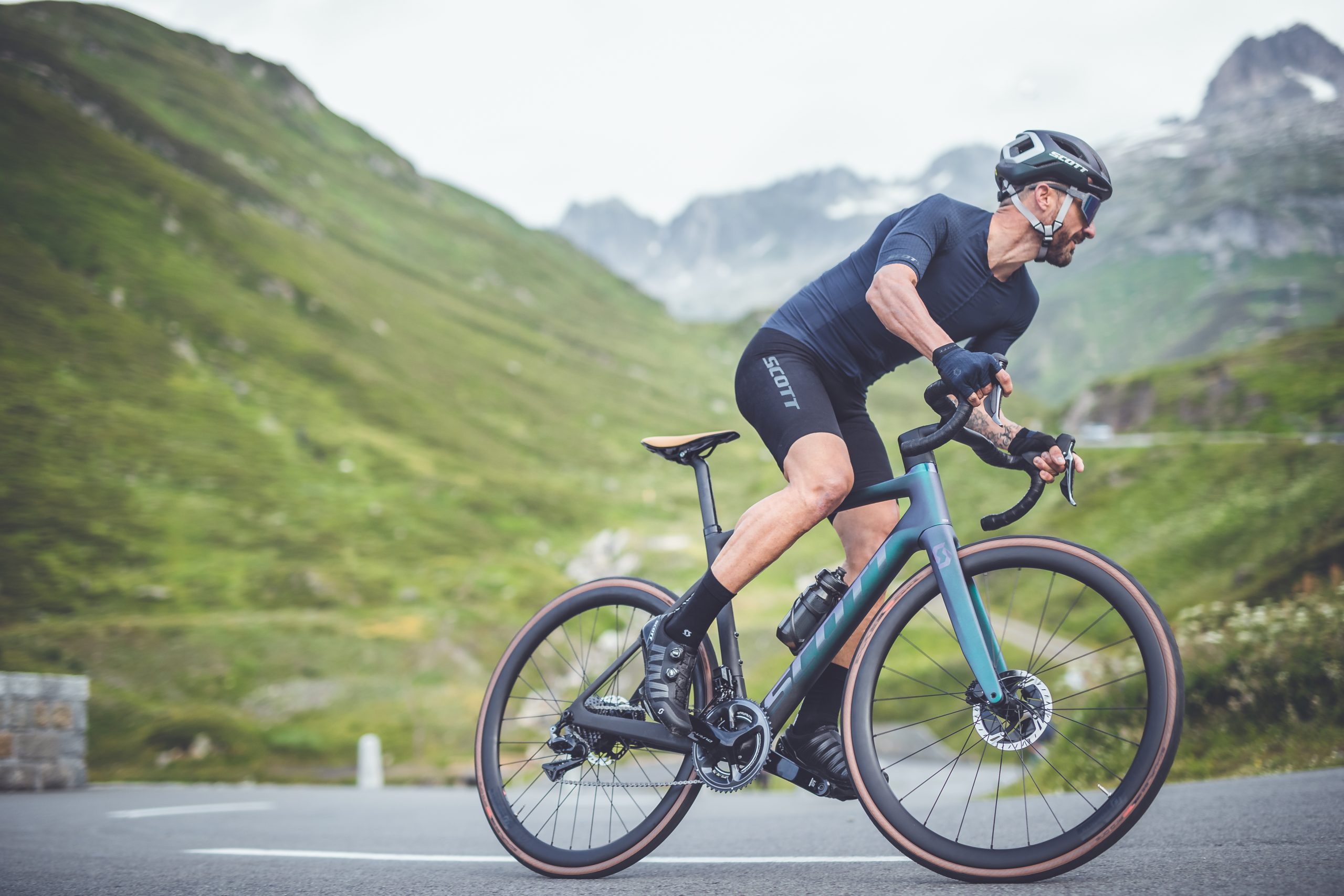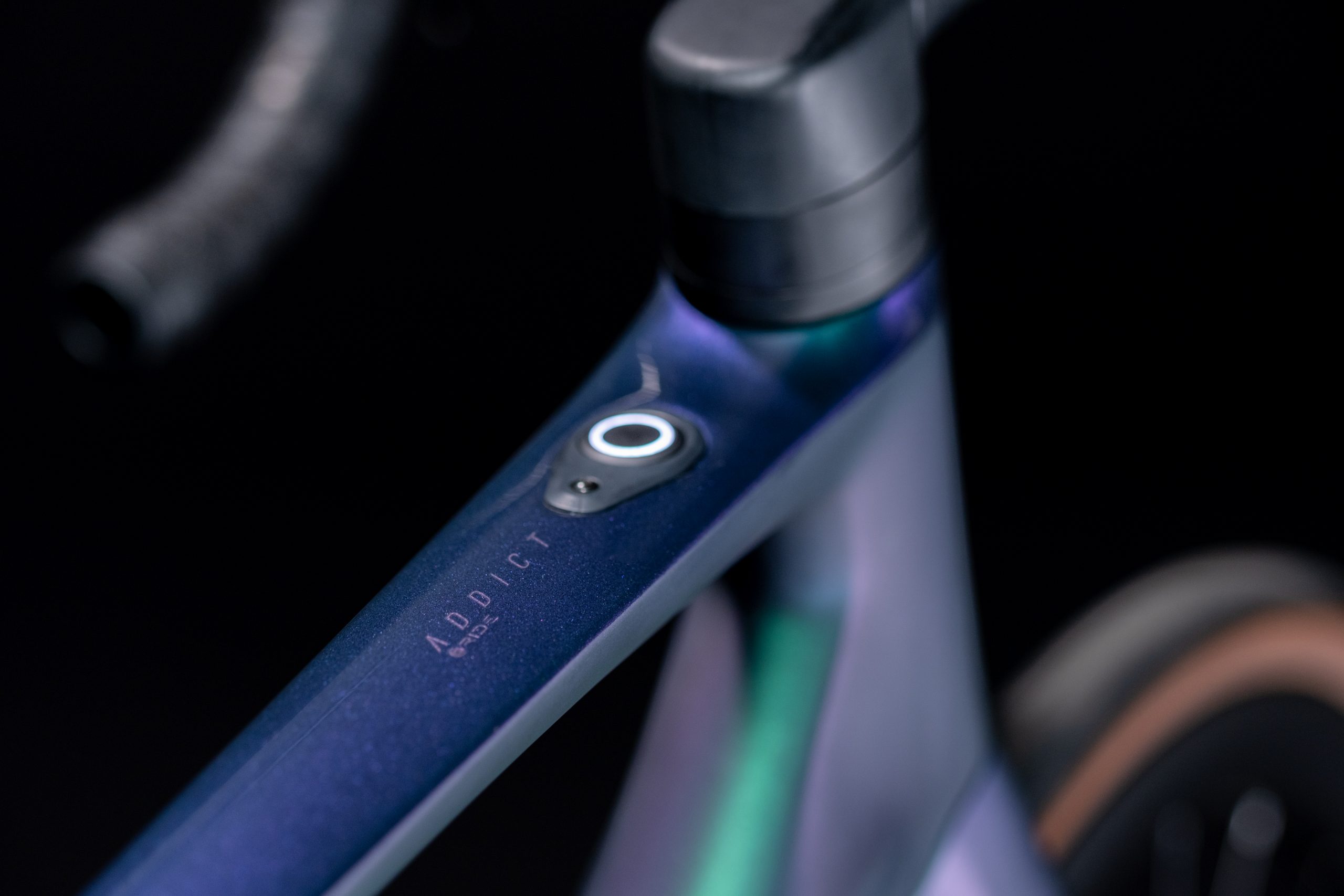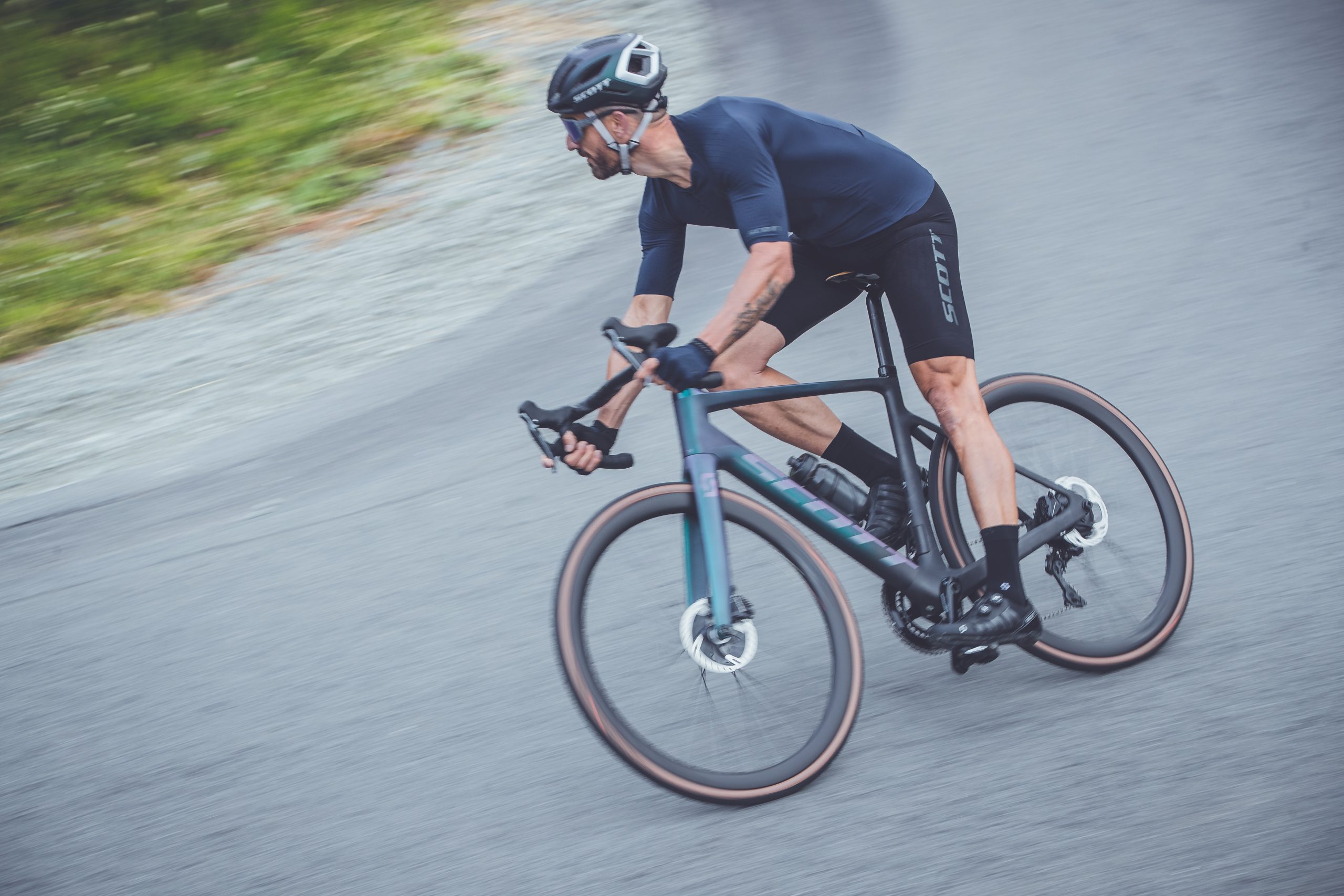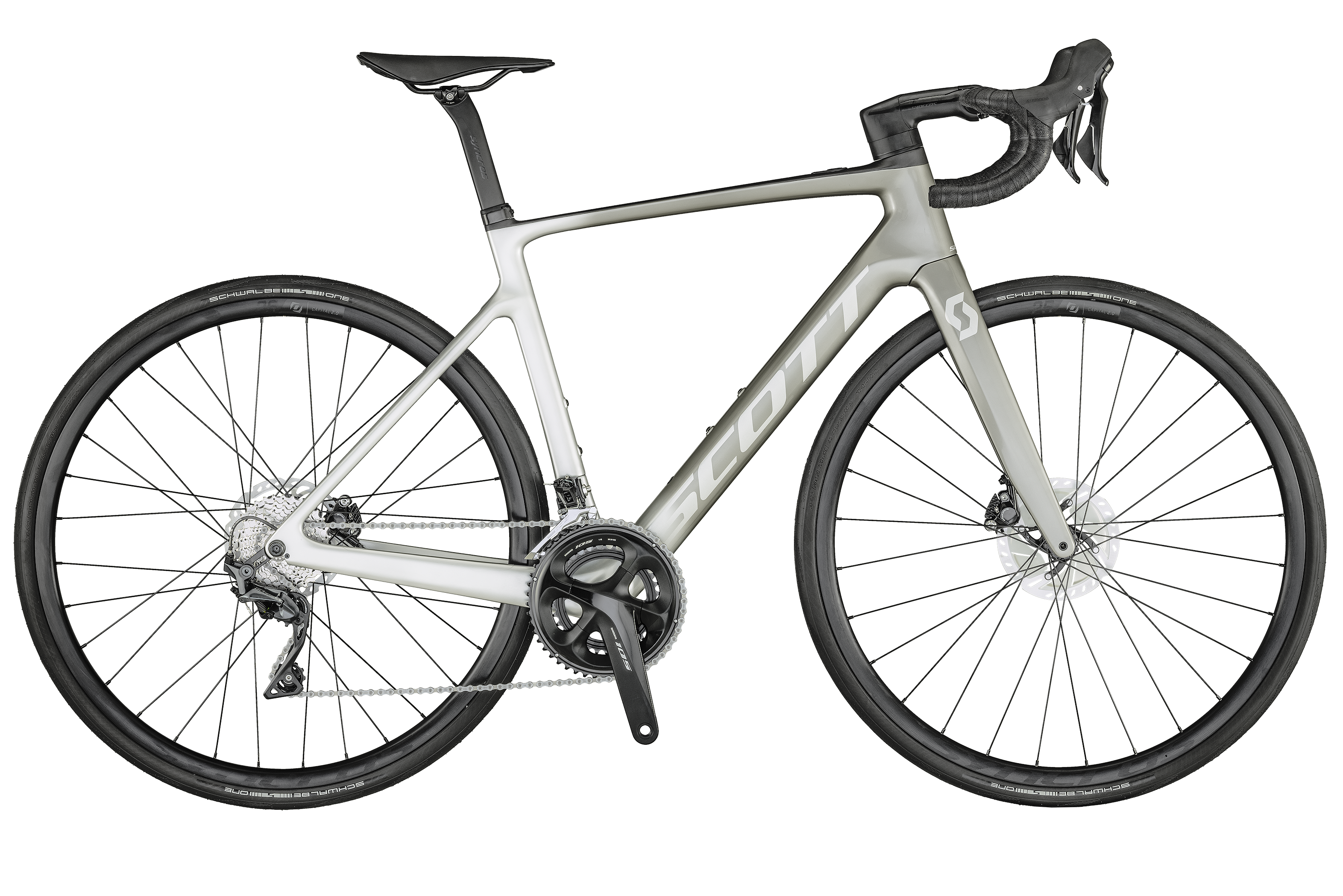Scott Addict eRide: our take on the lightest production electric road bike on the market
The brand has pulled the weight of a built bike down to 10.75kg


Scott has launched a motor-assisted version of its Addict road bike. The Scott Addict eRide is the lightest known production e-bike, taking the mantle from the Ribble Endurance SL e.
Scott's creation, in its lightest 'Premium' build comes in at 10.75 kg. We've got a size small on test, and placed it at 10.7kg (with bottle cages), though this is upped to 12.4kg with the added 'booster' battery'.
The Addict eRide uses a Mahle drive unit and battery, with the low torque motor hidden away in the rear hub.
With the booster and run at eco mode, the bike can provide a 73kg rider with a claimed 120km of riding, covering 2,200 metres of climbing. As ever, the capacity for the end-user will be impacted by a plethora of variables - from rider weight to wind direction.
As per all e-bikes, the Scott Addict eRide is limited to 25kph in the UK and Europe, whilst in the US that's boosted to 20mph.
The latest race content, interviews, features, reviews and expert buying guides, direct to your inbox!
The new Scott Addict eRide spares no expense, whilst the geometry has been toned down to create a comfortable ride, it's a performance focused build with prices starting at £3,999 with the top of the line model coming in at £8,349.
Lightweight road bike, with power
The new Addict eRide looks a lot like any other performance bike. Take away the booster battery, and unless you look at the rear hub, you'd be forgiven for confusing it with its Tour de France racing brethren. The carbon frame comes in at 1040g.
The geometry has been adjusted, to create a slightly more relaxed ride. A size 56 in the Addict eRide has a stack/reach of 593/384mm vs 568/395mm in the standard Addict, creating a slightly more upright ride. This set up will suit those without the strength or flexibility to hold an aggressive position without back pain.

In a standout move, the Addict eRide comes with entirely internal cable routing. The top of the range models come with an impressively slick looking one piece Syncros Creston IC SL / Carbon bar and stem combo, with a two piece Syncros Creston IC 1.5 compact bar and stem lower down the ladder.
Where the power comes from
Scott has turned to Mahle to provide the drive unit. Like most recent lightweight e-road bike creations, this is nestled in the rear hub and is a 36v/250w motor with a max torque of 40nm. A lower torque motor provides a more natural feel when compared with the high torque beasts you'd find on the likes of e-mountain bikes. As fun as it is to surge off the lights, you don't want to be jolting up the climbs.

The motor is supported by a 250Wh battery, that is hidden in the downtube and charged up via a port just below the bottle cage. There's then a 'rage booster' battery that adds an extra 208Wh, allowing you to ride further if you wish on one charge.
The system can be run in one of three modes, dictated by a colour change on the control button located on the top tube. Settings can be adjusted in the 'Ebikemotion' app, as well as being connected to a Garmin device.
The app itself provides a huge amount of adjustability, with riders able to tune the assistance given at each level, even setting power up to kick in automatically at a set heart rate zone as famously used by Sean Yates to allow him to ride despite a heart condition.
Who is the Scott Addict eRide for?
Whilst our muddy mountain biking brethren have embraced electric bikes, the e-Road market is still an emerging one.
Scott's own marketing material states "[making this bike] wasn't to make things easier. No, we wanted to make things tougher, to make climbs higher, longer, steeper. To get you out the house earlier, and back home later."
This very much speaks to the mountain bike world's approach to e-bikes: a motor allows you to ride for longer. However, it doesn't take into account the very real differences between the motivations of mountain bikers and those of road riders. The former uses uplifts to charge back down the trails, whilst for the majority of road riders, the achievement is in powering up the climbs - without assistance.

Scott's UK PR rep confirmed to us that the "higher, longer, steeper" description is a global approach, and it might work for a rider living in, say, the Dolomites. In the UK, the Scott Addict eRide very much looks to cater for the life long cyclist, who wants to join the club run but doesn't quite have the fitness to match that of their riding buddies. The motor allows them to keep pace on the climbs, whilst on the flat, when the pace is likely to exceed the 25kph/15mph max speed, it's light and aerodynamically unobtrusive allowing the rider to keep up.
A bike such as this could also be the missing piece of the puzzle for a would-be rider who wants to take up cycling but doesn't believe they have the fitness to get going on the journey. Finally, it could even replace a car by taking the edge of an otherwise arduous commute (as long as you can lock it somewhere safe).
The ride

I've had Scott's Addict eRide as part of my stable for a few weeks, giving me the opportunity to test it in a range of circumstances.
There's no question that the bike looks almost unrecognisable from the likes of the standard Addict. Lined up in my bike shed, it doesn't raise any eyebrows.
The finishing kit on this model is top draw. I absolutely love the sweeping handlebar shape and am looking forward to trying it on a standard Scott Addict. The 30mm Schwalbe Pro One TL tyres were extremely comfortable pumped up to 70psi.
The Syncros Belcarra Regular 1.0 saddle, comparatively, was not a match for me. I nearly always change the saddle on any test bike before the first ride, but the shape of this one lulled me into a false sense of security. Whilst bums are like snowflakes (unique) I'd suggest that any women looking to buy this bike swap the saddle for something designed with a female (or unisex) rider at front of mind.
Charging the bike was easy, though of course it did mean bringing it indoors and setting it up next to a plug socket.

I used the bike to carry me out of Caterham Valley, where I live, to Reigate (where my favourite bike shop lives). I was keen to see if this bike could provide an alternative to driving, for example on a day where I'd already completed a training session on a standard bike and simply want to get from A to B.
Hitting the road, selecting the highest power mode had me smiling instantly. Whilst it's true that the motor doesn't 'surge' in eco mode, in the highest setting it does give a grin inducing jolt (you can turn it down if you don't want that).
The hills en route were rendered significantly easier, but not without effort. As an example, Shepard's Hill between Merstham and Caterham took me 3 minutes 10 to complete, with an average heart rate of 159bpm. Comparatively, my best un-assisted effort is 3 minutes 30 at 180bpm. I didn't equip the Addict eRide with a power meter but hopefully it's obvious that the lower heart rate was a response to lower power required.
On commute style rides, my overall ride time was actually little different to that on an unassisted bike. On flat sections when I found myself going over 15mph/25kph and losing the motor support, I backed off.
The only issue with the idea of using this bike to commute is that it's a high priced item to leave locked up outside, but if you're going from home to a workplace with secure bike parking that issue is less pressing, provided you don't need to stop off and buy dinner en route home.
Outside of commute duties, with so much DNA of the Addict passed on, the Addict eRide would absolutely present a tantaslising option for a cyclist who wants to join in on group rides with friends, but doesn't share the same fitness level. With the booster battery fitted, it's quite a heavy machine, but take that off and you've got a bike that weighs about the same as plenty of un-assisted entry-level bikes.
The only area I see being an issue would be those hard, fast power climbs found on undulating roads - where the speed might be in excess of 15mph/25kph, especially if preceded by a short descent. On this sort of terrain, the weight of the rear hub was noticeable. However, if your riding buddies are minded to, they could no doubt control the pace here and ensure the ride stayed together.
I was keen to see if e-bikes are really the answer when it comes to allowing people of different fitness levels to ride together. So I lent the bike to a couple I know - George (a competitive cyclist) and Lara (a novice cyclist). The pair completed a 40km route, with Lara commenting that though riding the bike was not without effort, she found it more enjoyable than the handful of rides they've done together whilst she's been riding an unassisted bike - adding that she'd be more likely to join George for rides in the future on a bike like this.
The Mahle system pairs up with its eBikmotion app, this can be used to adjust the settings and also track rides if you use a phone mount on the bars. I instead opted to pair the bike with my Garmin 1030 computer - and this allowed me to adjust the amount of assistance used, and see the battery life.

The assistance modes can also be controlled via the button on the top tube. However, communication is via a selection if flashing lights in different colours. It's not instantly clear what each colour refers to, and I found using this system meant taking my eyes off the road for longer than I'd like - so the Garmin control would always be my preference. This comment was backed up by Lara, who also found the system difficult to operate whilst riding, and it's a criticism we voiced of the Ribble Endurance SL e which also adopts this format.
Specs
Addict eRide Premium

- Sizes XS-XL
- Shimano Dura Ace Di2, 50x34, 11-30
- Syncros Captial 1.0 disc wheels
- Syncros Creston IC SL bar/stem
- Syncros Duncan SL aero seatpost
- Syncros Belcarra Regular 1.0 saddle
- Schwalbe Pro One TL tyres, 30c
- Weight 10.75kg
- RRP: £8349
Addict eRide 10

- Sizes XS-XL (available in women's model with adjusted touchpoints)
- Shimano Ultegra, 50x34, 11-32
- Syncros Captial 1.0 disc wheels
- Syncros Creston IC 1.5 compact bar and Syncros RRiC stem
- Syncros Duncan SL aero seatpost
- Syncros Belcarra Regular 1.0 saddle
- Schwalbe Pro One TL tyres, 30c
- Weight: 11.6kg
- RRP: £5649
Addict eRide 20

- Sizes XS-XL
- Shimano Ultegra, 50x34, 11-32
- Syncros Captial 2.0 disc wheels
- Syncros Creston 2.0 compact bar and Syncros RRiC stem
- Syncros Duncan SL aero seatpost
- Syncros Belcarra Regular 1.0 saddle
- Schwalbe Pro One TL tyres, 30c
- Weight: 12kg
- RRP: £3999
Michelle Arthurs-Brennan the Editor of Cycling Weekly website. An NCTJ qualified traditional journalist by trade, Michelle began her career working for local newspapers. She's worked within the cycling industry since 2012, and joined the Cycling Weekly team in 2017, having previously been Editor at Total Women's Cycling. Prior to welcoming her first daughter in 2022, Michelle raced on the road, track, and in time trials, and still rides as much as she can - albeit a fair proportion indoors, for now.
Michelle is on maternity leave from April 2025 until spring 2026.
